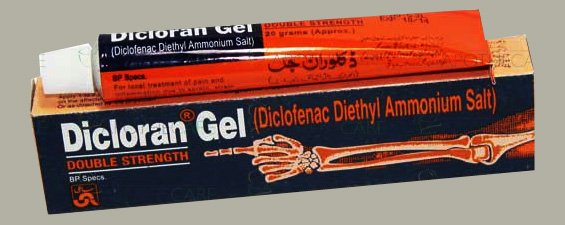Dicloran Gel (Diclofenac) is a non-steroidal anti-inflammatory drug. It inhibits prostaglandins synthesis by decreasing the activity of the enzyme, cyclooxygenase, which results in decreased formation of prostaglandin precursors.
Dicloran Gel relieves pain, reduces edema and shortens the time to return to normal function in inflammation of traumatic or rheumatic origin.
How Dicloran Gel Works?
- Absorption
The amount of Diclofenac absorbed through the skin is proportional to the contact time and skin area covered with Dicloran Gel, topical dose and hydration of skin. - Distribution
After topical administration to hand and knee joints, Diclofenac can be measured in plasma, synovial tissue, and synovial fluid. - Elimination
Diclofenac and its metabolites are mainly excreted in urine
What is Dicloran Gel Used For?
- Dicloran Gel is used to treat the post-traumatic inflammation of the tendons, ligaments, muscles, and joints, e.g. due to sprains, strains, and bruises,
- Localized form of soft-tissue rheumatism, e.g. tendovaginitis, bursitis, shoulder-hand syndrome and periarthropathy,
- Localized form of degenerative rheumatism, e.g. osteoarthritis of the peripheral joints and of the vertebral column.
Recommended Dosage & Administration
Apply 1 – 2gm Gel 3 to 4 times daily on the affected area and rub gently. After application the hands should be washed, unless they are the site being treated. The duration of treatment depends on the indication and the response obtained. It is recommended that treatment be reviewed after 2 weeks or as directed by the physician
When to avoid using Dicloran Gel?
Individuals with known hypersensitivity to Diclofenac or any other ingredient of this formulation should not use Dicloran Gel. It is also contra-indicated in patients in whom attacks of asthma, urticaria or acute rhinitis are precipitated by acetylsalicylic acid (e.g. Ascard) or other NSAIDs
Special Precautions
Dicloran Gel should be applied only to healthy and intact skin surfaces. It should not be allowed to come in contact with the eyes or with mucous membrane and NOT to be taken by mouth. Dicloran Gel Should be used for topical application only, moreover it is not recommended to use this medicinal product during pregnancy and lactation.
Possible Side Effects of Dicloran Gel
Occasionally allergic or non-allergic contact dermatitis have been reported. In isolated cases generalized skin rashes, hypersensitivity reactions and photosensitivity reactions may also occur when using Dicloran Gel.

Leave A Comment